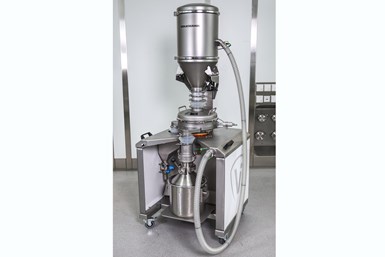Volkmann Powder Recovery System Reprocesses Excess Material
The metal powder reprocessing system transfers material to 3D printers, recovers the unused material, screens it and then returns the material to the machine or a container for future use.
Share





Volkmann USA’s PowTReX Basic metal powder reprocessing system offers safe metal powder transfer, recovery and extraction systems for AM.
Featuring the core functions of the company’s original PowTReX, the PowTReX Basic integrates metal powder transfer, extraction and sieving into a compact unit designed to permit the recovery and reprocessing of excess material.
Developed to serve a single 3D printer, the PowTReX Basic enables 3D printing companies to extract excess metallic powder from the build chamber by suction lance, then automatically sieve the extracted powder to remove any oversize particles. Sieved powder is collected inside for reuse, while oversize particles are diverted for removal.
Developed for use as stand-alone system for small- to medium-volume 3D printers, PowTReX basic conveys up to 750 kg/hr, stores up to 25 liters of metal powder within the integrated storage tank, and is set on casters for smooth movement from one printer to another printer.
The PowTReX Basic is offered with the company’s companion vDryer vacuum dryer, vLoader metal powder loading system and a range of accessories as options. Custom configurations for nearly any AM process are also available.
The PowTReX can also roll to 3D printers for easy installation and movement. The system now features a mobility package as standard.
Related Content
-
Designing a 3D Printed Part with Machining in Mind
Designing extra stock and mounting features into a 3D printed part can aid in machining processes downstream.
-
The Cool Parts Showcase Seeks Innovative 3D Printed Parts
Do you solve problems with 3D printing? Enter your 3D printed parts in this contest from The Cool Parts Show.
-
Digitalization and Done-In-One Reign Supreme at BIEMH 2024
European manufacturers may have a different balance of markets than their U.S. counterparts, but the practical challenges they must overcome are often similar — as are the solutions.

























